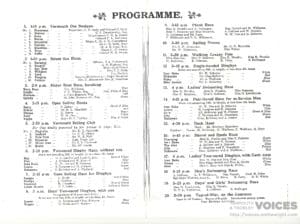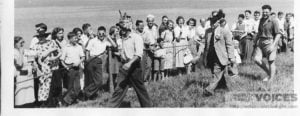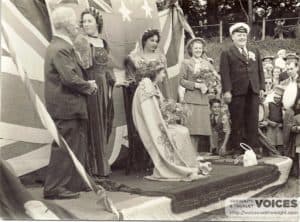Peace Celebrations were held in 1946, with harbour sports.
1948 seems to have been the first full carnival after the end of WWII and demob.

Billy Doe crowns Carnival Queen : photo Sue Russell
Raich Doe front left, Bob Cook, and contributors Serena Hunt, Susan Hayles in Brownie uniform, Effie Pitman behind Sue, Derek Pomroy with cub Peter Stallard
In 1949 a Carnival Queen was chosen by votes at the ‘Con Club’ from a bevy of local beauties .
From left: Jean Levey, Ella Jackman, Pam Henderson (chosen to be Queen), Mrs Eames, Barbara Holloway, Annette Holloway, Pat Adams, (chosen as attendant) Jessie Attrill, with Newt Kelsey judging or looking on.
At the crowning ceremony are: from left, Robert May, Heather Harris (married Raich Doe), Pat Adams (married Mick Burt), Pam Henderson, Carnival Queen, Miss New Zealand, and Mr J. Flanders who officiated.
The boy peeping between is John Orchard, staying with his Uncle who had a taxi.
Miss New Zealand was persuaded by Mrs Hans Hamilton to put in an appearance, and seemed to enjoy the parade.







